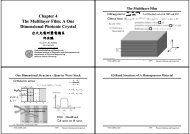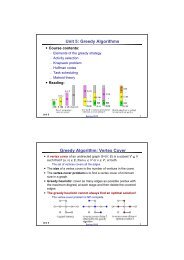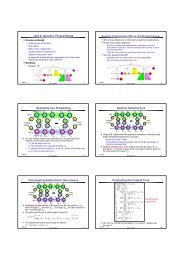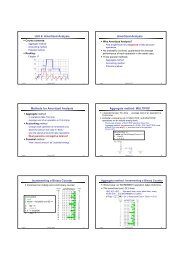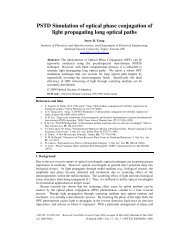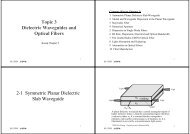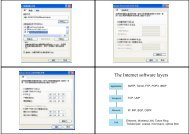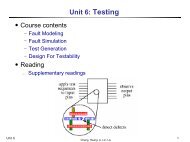Create successful ePaper yourself
Turn your PDF publications into a flip-book with our unique Google optimized e-Paper software.
Unit 3: Data Structures on Trees<br />
<strong>․Course</strong> contents:<br />
<br />
<br />
Binary search trees<br />
Red-black trees<br />
<strong>․Readings</strong>:<br />
Chapters 10 (self reading), 12, 13, and 14 (self reading<br />
for Chapter 14)<br />
Unit 3 Spring 2013<br />
1
Binary Search Tree<br />
․ Binary-search-tree (BST) property: Let x be a node in a BST.<br />
If y is a node in the left subtree of x, then y.key x.key.<br />
If y is a node in the right subtree of x, then x.key y.key.<br />
․ Tree construction: Worst case: O(n 2 ); average case: O(n lgn), where<br />
n is the # of nodes.<br />
․ Operations Search, Minimum, Maximum, Predecessor,<br />
Successor, Insert, Delete can be performed in O(h) time, where h is<br />
the height of the tree.<br />
․ Worst case: h = (n); balanced BST: h = (lgn).<br />
․ Can we guarantee h = (lgn)? Balance search trees!!<br />
Unit 3 Spring 2013<br />
2
Tree Search<br />
․Operations Search can be performed in O(h) time, where h is<br />
the height of the tree.<br />
Iterative-Tree-Search(x, k)<br />
1. while x NIL and k x.key<br />
2. if k < x.key<br />
3. x = x.left<br />
4. else x = x.right<br />
5. return x<br />
Unit 3 Spring 2013<br />
3
Tree Successor<br />
Tree-Successor(x)<br />
1. if x.right NIL<br />
2. return Tree-Minimum(x.right)<br />
3. y = x.p<br />
4. while y NIL and x == y.right<br />
5. x = y<br />
6. y = y.p<br />
7. return y<br />
x<br />
y<br />
y<br />
Tree-Minimum(x)<br />
1. while x.left NIL<br />
2. x = x.left<br />
3. return x<br />
y is the lowest ancestor of<br />
x, whose left child is also<br />
an ancestor of x<br />
x<br />
4<br />
Unit 3 Spring 2013<br />
4
Tree Insertion<br />
․Insert z into tree T.<br />
Tree-Insert(T, z)<br />
1. y = NIL<br />
2. x = T.root<br />
3. while x NIL<br />
4. y = x<br />
5. if z.key < x.key<br />
6. x = x.left<br />
7. else x = x.right<br />
8. z.p = y<br />
9. if y == NIL<br />
10. T.root = z // T is<br />
empty<br />
11. elseif z.key < y.key<br />
12. y.left = z<br />
13. else y.right = z<br />
4<br />
xy<br />
x<br />
z<br />
xy<br />
Unit 3 Spring 2013<br />
5
Deletion in Binary Search Trees<br />
․ Case 1: The node to be deleted (z) has no children (i.e., a leaf).<br />
․ Case 2: The node to be deleted (z) has only one child.<br />
․ Case 3: The node to be deleted (z) has two children.<br />
3<br />
successor<br />
y<br />
NIL<br />
6<br />
5<br />
12<br />
10<br />
7<br />
z<br />
x<br />
r<br />
15<br />
3<br />
5<br />
z<br />
7<br />
6<br />
10<br />
x<br />
y<br />
12<br />
r<br />
15<br />
3<br />
7<br />
y<br />
6<br />
12<br />
10<br />
x<br />
r<br />
15<br />
Unit 3 Spring 2013<br />
6
Deleting z in a Binary Search Tree<br />
NIL<br />
q<br />
z<br />
q<br />
Transplant(T, z, r)<br />
q<br />
z<br />
Transplant(T, z, l)<br />
r<br />
r<br />
l NIL<br />
q<br />
l<br />
l<br />
3<br />
q<br />
z<br />
NIL<br />
l<br />
3<br />
y<br />
x<br />
z<br />
r<br />
l<br />
3<br />
q<br />
y<br />
x<br />
z<br />
Transplant(T, u, v)<br />
1. if u.p == NIL<br />
2. T.root = v<br />
3. elseif u == u.p.left<br />
4. u.p.left = v<br />
5. else u.p.right = v<br />
6. if v NIL<br />
7. v.p = u.p<br />
y<br />
r<br />
y<br />
replace subtree<br />
rooted at u<br />
with subtree<br />
rooted at v<br />
r<br />
successor<br />
y<br />
NIL<br />
x<br />
Unit 3 Spring 2013<br />
x<br />
x<br />
7
Tree Deletion<br />
Tree-Delete(T, z)<br />
1. if z.left == NIL // case A<br />
2. Transplant(T, z, z.right)<br />
3. elseif z.right == NIL // case B<br />
4. Transplant(T, z, z.left)<br />
5. else y = Tree-Minimum(z.right)<br />
6. if y.p z // case D<br />
7. Transplant(T, y, y.right)<br />
8. y.right = z.right<br />
9. y.right.p = y<br />
10. Transplant(T, z, y) // case C<br />
11. y.left = z.left<br />
12. y.left.p = y<br />
NIL<br />
q<br />
l<br />
z<br />
3<br />
r<br />
q<br />
z<br />
y<br />
NIL<br />
q<br />
r<br />
Case A<br />
x<br />
l<br />
l<br />
Case C<br />
q<br />
q<br />
z<br />
NIL<br />
3<br />
Case B<br />
q<br />
y<br />
x<br />
l<br />
Case D<br />
l<br />
3<br />
z<br />
r<br />
z<br />
y<br />
r<br />
y<br />
r<br />
successor<br />
y<br />
x<br />
NIL<br />
Unit 3 Spring 2013<br />
x<br />
x<br />
8
Balanced Search Trees: Red-Black Trees<br />
․ Add color field to nodes of binary trees.<br />
․ Red-black tree properties:<br />
1. Every node is either red or black.<br />
2. The root is black.<br />
3. Every leaf (NIL) is black.<br />
4. If a node is red, both its children are black (i.e., no two<br />
consecutive reds on a simple path).<br />
5. Every simple path from a node to a descendent leaf contains<br />
the same # of black nodes.<br />
T.nil for all NIL’s<br />
(also for root’s parent)<br />
Unit 3 Spring 2013<br />
9
Black Height<br />
․ Black height of node x, bh(x): # of blacks on path to leaf, not<br />
counting x.<br />
․ A red-black tree with n internal nodes has height at most 2lg(n+1).<br />
Strategy: First bound the # of nodes in any<br />
subtree, then bound the height of any subtree.<br />
Claim 1: Any subtree rooted at x has 2 bh(x) -1<br />
internal nodes.<br />
Proof by induction:<br />
bh(x) = 0 x is a NIL (leaf) node.<br />
Assume the claim is true for all trees with black<br />
height < bh(x).<br />
If x is red, both subtrees have black height<br />
bh(x) - 1.<br />
If x is black, both subtrees have black height<br />
at least bh(x)-1.<br />
Thus, # of internal nodes in any subtree rooted<br />
at x is<br />
n x<br />
(2 bh(x)-1 -1) + (2 bh(x)-1 -1) + 1 2 bh(x) -1.<br />
Unit 3 Spring 2013<br />
10
Black Height (cont'd)<br />
․Let h be the height of the red-black tree.<br />
<br />
<br />
Claim 2: bh(root) h/2. (i.e., at least half the nodes on any<br />
single path from the root to leaf must be black.)<br />
By Property 4: h/2 nodes on that path are red.<br />
At root,<br />
n 2 bh(root) -1 2 h/2 -1<br />
h 2 lg(n+1).<br />
․Thus, red-black trees are balanced. (Height is at most<br />
twice optimal.)<br />
․Corollary: Search, Minimum, Maximum, Predecessor,<br />
Successor take O(lgn) time.<br />
․How about Delete and Insert?<br />
<br />
Need to maintain the red-black tree properties!<br />
Unit 3 Spring 2013<br />
11
Rotations<br />
․Left/right rotations: The basic restructuring step for<br />
binary search trees.<br />
․Rotation is a local operation changing O(1) pointers.<br />
․In-order property preservation: An in-order search<br />
tree before a rotation stays an in-order one.<br />
In-order: <br />
<br />
The property of a binary search tree still holds!!<br />
Unit 3 Spring 2013<br />
12
Left Rotation<br />
Left-Rotate(T, x)<br />
1. y = x.right // Set y<br />
2. x.right = y.left // Turn y's left subtree into x's right subtree<br />
3. if y.left T.nil<br />
4. y.left.p = x<br />
5. y.p = x.p // Link x's parent to y<br />
6. if x.p == T.nil<br />
7. T.root = y<br />
8. elseif x == x.p.left // x is a left child<br />
9. x.p.left = y<br />
10. else x.p.right = y<br />
11. y.left = x // Put x on y's left<br />
12. x.p = y<br />
Unit 3 Spring 2013<br />
13
Insertion<br />
․Every insertion takes place at a leaf; this changes a<br />
black NIL pointer to a node with two black NIL pointers.<br />
․To preserve the black height of the tree, the new node<br />
is set to red.<br />
<br />
If the new parent is black, then we are done; otherwise, we<br />
must restructure (Property 4 violation)!!<br />
․How to fix two reds in a row? Check uncle's color!<br />
<br />
If the uncle is red, reversing the relatives' colors either solves<br />
the problem or pushes it one-level higher.<br />
Unit 3 Spring 2013<br />
14
Insertion: Black Uncle<br />
․How to fix two reds in a row? Check uncle's color!<br />
<br />
<br />
If the uncle is black (all nodes around the new node and its<br />
parent must be black), rotate right about the grandparent.<br />
Change some nodes' colors to make the black height the same<br />
as before.<br />
Unit 3 Spring 2013<br />
15
RB-Tree Insertion<br />
RB-Insert(T, z) // insert z into T<br />
1. y = T.nil<br />
2. x = T.root<br />
3. while x T.nil<br />
4. y = x<br />
5. if z.key < x.key<br />
6. x = x.left<br />
7. else x = x.right<br />
8. z.p = y<br />
9. if y == T.nil<br />
10. T.root = z // T is empty<br />
11. elseif z.key < y.key<br />
12. y.left = z<br />
13. else y.right = z<br />
14. z.left = T.nil<br />
15. z.right = T.nil<br />
16. z.color = RED<br />
17. RB-Insert-Fixup(T,z)<br />
4<br />
xy<br />
x<br />
z<br />
xy<br />
Unit 3 Spring 2013<br />
16
RB-Tree Insertion Fixup<br />
RB-Insert-Fixup(T, z)<br />
1. while z.p.color == RED<br />
2. if z.p == z.p.p.left<br />
3. y = z.p.p.right<br />
4. if y.color == RED<br />
5. z.p.color = BLACK // case 1<br />
6. y.color = BLACK // case 1<br />
7. z.p.p.color = RED // case 1<br />
8. z = z.p.p // case 1<br />
9. else if z == z.p.right<br />
10. z = z.p // case 2<br />
11. Left-Rotate(T, z) // case 2<br />
12. z.p.color = BLACK // case 3<br />
13. z.p.p.color = RED // case 3<br />
14. Right-Rotate(T, z.p.p) // case 3<br />
15. else (same as then clause with<br />
“right” and “left” exchanged)<br />
16. T.root.color = BLACK<br />
z<br />
z<br />
z<br />
Case 1<br />
Case 2<br />
Unit 3 Spring 2013<br />
17
RB-Tree Insertion Fixup (cont’d)<br />
RB-Insert-Fixup(T, z)<br />
1. while z.p.color == RED<br />
2. if z.p == z.p.p.left<br />
3. y = z.p.p.right<br />
4. if y.color == RED<br />
5. z.p.color = BLACK // case 1<br />
6. y.color = BLACK // case 1<br />
7. z.p.p.color = RED // case 1<br />
8. z = z.p.p // case 1<br />
9. else if z == z.p.right<br />
10. z = z.p // case 2<br />
11. Left-Rotate(T, z) // case 2<br />
12. z.p.color = BLACK // case 3<br />
13. z.p.p.color = RED // case 3<br />
14. Right-Rotate(T, z.p.p) // case 3<br />
15. else (same as then clause with<br />
“right” and “left” exchanged)<br />
16. T.root.color = BLACK<br />
z<br />
z<br />
Case 3<br />
Unit 3 Spring 2013<br />
18
Deleting z in an RB-Tree<br />
T.nil<br />
q<br />
z<br />
Transplant(T, z, r)<br />
r<br />
q<br />
r<br />
l<br />
q<br />
Transplant(T, z, l)<br />
z<br />
T.nil<br />
q<br />
l<br />
l<br />
3<br />
q<br />
z<br />
T.nil<br />
y<br />
x<br />
l<br />
3<br />
q<br />
y<br />
x<br />
RB-Transplant(T, u, v)<br />
1. if u.p == T.nil<br />
2. T.root = v<br />
3. elseif u == u.p.left<br />
4. u.p.left = v<br />
5. else u.p.right = v<br />
6. v.p = u.p<br />
replace subtree<br />
rooted at u<br />
with subtree<br />
rooted at v<br />
l<br />
3<br />
z<br />
r<br />
z<br />
y<br />
r<br />
y<br />
r<br />
successor<br />
y<br />
T.nil<br />
x<br />
Unit 3 Spring 2013<br />
x<br />
x<br />
19
RB-Delete(T, z)<br />
1. y = z<br />
2. y-original-color = y.color<br />
3. if z.left == T.nil // case A<br />
4. x = z.right<br />
5. RB-Transplant(T, z, z.right)<br />
6. elseif z.right == T.nil // case B<br />
7. x = z.left<br />
8. RB-Transplant(T, z, z.left)<br />
9. else y = Tree-Minimum(z.right)<br />
10. y-original-color = y.color<br />
11. x = y.right<br />
12. if y.p == z // case C<br />
13. x.p = y<br />
14. else RB-Transplant(T, y, y.right)<br />
15. y.right = z.right // case D<br />
16. y.right.p = y<br />
17. RB-Transplant(T, z, y) // cases C,<br />
D<br />
18. y.left = z.left<br />
19. y.left.p = y<br />
20. y.color = z.color<br />
21. if y-original-color == BLACK<br />
22. RB-Delete-Fixup(T, x)<br />
RB-Tree Deletion<br />
T.nil<br />
Unit 3 Spring 2013<br />
x<br />
q<br />
l<br />
q<br />
z<br />
3<br />
z<br />
x<br />
T.nil<br />
q<br />
z<br />
T.nil<br />
y<br />
q<br />
q<br />
x<br />
x<br />
Case A<br />
Case B<br />
x<br />
• If y is black, call<br />
RB-Delete-<br />
Fixup (line 22)<br />
to fix the black<br />
height<br />
• z: the deleted<br />
node<br />
• x: y's sole child<br />
l<br />
Case C<br />
3<br />
q<br />
y<br />
x<br />
20
RB-Tree Deletion (cont’d)<br />
RB-Delete(T, z)<br />
1. y = z<br />
2. y-original-color = y.color<br />
3. if z.left == T.nil // case A<br />
4. x = z.right<br />
5. RB-Transplant(T, z, z.right)<br />
6. elseif z.right == T.nil // case B<br />
7. x = z.left<br />
8. RB-Transplant(T, z, z.left)<br />
9. else y = Tree-Minimum(z.right)<br />
10. y-original-color = y.color<br />
11. x = y.right<br />
12. if y.p == z // case C<br />
13. x.p = y<br />
14. else RB-Transplant(T, y, y.right)<br />
15. y.right = z.right // case D<br />
16. y.right.p = y<br />
17. RB-Transplant(T, z, y) // cases C, D<br />
18. y.left = z.left<br />
19. y.left.p = y<br />
20. y.color = z.color<br />
21. if y-original-color == BLACK<br />
22. RB-Delete-Fixup(T, x)<br />
Case D<br />
x<br />
l<br />
3<br />
successor<br />
y<br />
z<br />
T.nil<br />
y<br />
r<br />
x<br />
z<br />
y<br />
x<br />
r<br />
r<br />
• If y is black,<br />
call RB-Delete-<br />
Fixup (line 22)<br />
to fix the black<br />
height<br />
• z: the deleted<br />
node<br />
• x: y's sole child<br />
Unit 3 Spring 2013<br />
21
Deletion Color Fixup<br />
․If y is black, we must give each of its descendants<br />
another black ancestor push y's blackness onto its<br />
child x.<br />
․If an appropriate node is red, simply color it black; must<br />
restructure, otherwise.<br />
Black NIL becomes doubly black.<br />
Red becomes black.<br />
Black becomes doubly black.<br />
․Goal: Recolor and restructure the tree so as to get rid of<br />
doubly black.<br />
․Key: Move the extra black up the tree until<br />
x points to a red node, simply color it black.<br />
x points to the root, the extra black can simply be removed.<br />
Suitable rotations and recolorings can be performed.<br />
Unit 3 Spring 2013<br />
22
Four Cases for Color Fixup<br />
․ Case 1: The doubly black node x has a red sibling w.<br />
․ Case 2: x has a black sibling and two black nephews.<br />
․ Case 3: x has a black sibling, and its left nephew is red and its<br />
right nephew is black.<br />
․ Case 4: x has a black sibling, and its right nephew is red (left<br />
nephew can be any color).<br />
․ The # of black nodes in each path is preserved.<br />
․ At most 3 rotations are done; only case 2 can be repeated.<br />
A<br />
B<br />
Unit 3 Spring 2013<br />
23
Case 1 for Color Fixup<br />
․Case 1: The doubly black node x has a red sibling w.<br />
․One left rotation around x.p and constant # of color<br />
changes are done.<br />
․The # of black nodes in each path is preserved.<br />
․Converts into case 2, 3, or 4.<br />
Unit 3 Spring 2013<br />
24
Case 2 for Color Fixup<br />
․Case 2: x has a black sibling and two black nephews.<br />
․Take off one black from x and its sibling, push one<br />
black up to x.p, and repeat the while loop with x.p as<br />
the new node x.<br />
․The # of black nodes in each path is preserved.<br />
․Perform constant # of color changes and repeat at<br />
most O(h) times. (No rotation!!)<br />
B<br />
Unit 3 Spring 2013<br />
25
Case 3 for Color Fixup<br />
․Case 3: x has a black sibling, and its left nephew is red<br />
and its right nephew is black.<br />
․Perform a right rotation on x’s sibling and constant # of<br />
color changes.<br />
․The # of black nodes in each path is preserved.<br />
․Convert into case 4.<br />
Unit 3 Spring 2013<br />
26
Case 4 for Color Fixup<br />
․Case 4: x has a black sibling, and its right nephew is<br />
red (left nephew can be any color).<br />
․Performs a left rotation on x.p and constant # of color<br />
changes => remove the doubly black on x.<br />
․The # of black nodes in each path is preserved.<br />
․Make x as the root and terminate the while loop.<br />
Unit 3 Spring 2013<br />
27
Color Fixup for Deletion<br />
RB-Delete-Fixup(T,x)<br />
1. while x T.root and x.color == BLACK<br />
2. if x == x.p.left<br />
3. w = x.p.right<br />
4. if w.color == RED<br />
5. w.color = BLACK // Case 1<br />
6. x.p.color = RED // Case 1<br />
7. Left-Rotate(T, x.p) // Case 1<br />
8. w = x.p.right // Case 1<br />
9. If w.left.color == BLACK and w.right.color == BLACK<br />
10. w.color = RED // Case 2<br />
11. x = x.p // Case 2<br />
12. else if w.right.color == BLACK<br />
13. w.left.color = BLACK // Case 3<br />
14. w.color = RED // Case 3<br />
15. Right-Rotate(T, w) // Case 3<br />
16. w = x.p.right // Case 3<br />
17. w.color = x.p.color // Case 4<br />
18. x.p.color = BLACK // Case 4<br />
19. w.right.color = BLACK // Case 4<br />
20. Left-Rotate(T, x.p) // Case 4<br />
21. x = T.root<br />
22. else (same as then clause with "right" and "left" exchanged)<br />
23. x.color = BLACK<br />
Unit 3 Spring 2013<br />
28
Conclusion: Red-Black Trees<br />
․Red-black trees are balanced binary search trees.<br />
․All dictionary operations (Minimum, Maximum, Search,<br />
Successor, Predecessor, Insert, Delete) can be<br />
performed in O(lg n) time.<br />
․At most 3 rotations are done to rebalance.<br />
Unit 3 Spring 2013<br />
29



